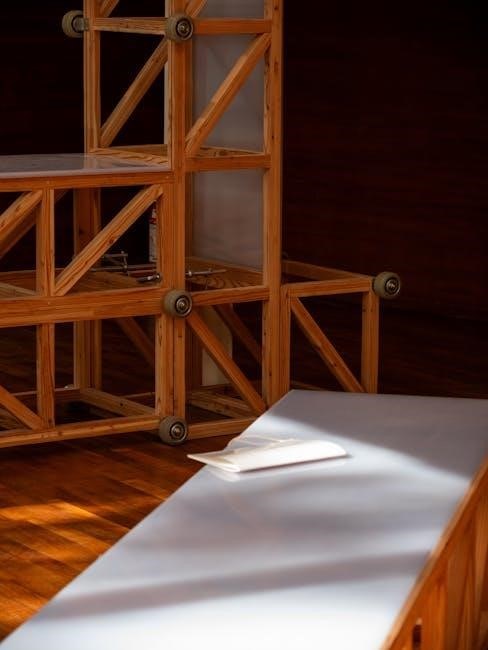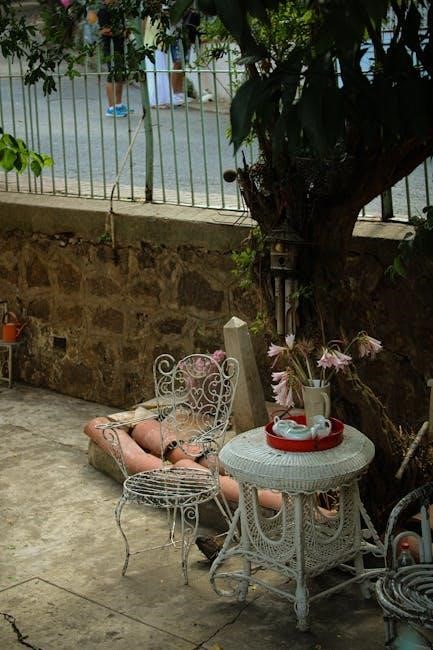Temperature conversion is essential for understanding different scales like Celsius and Fahrenheit․ This guide provides a detailed Celsius to Fahrenheit table PDF for quick reference and accurate conversions․
1․1 Importance of Celsius to Fahrenheit Conversion
The ability to convert temperatures between Celsius and Fahrenheit is crucial in various fields, including cooking, weather forecasting, and scientific research․ Many countries use Fahrenheit for daily weather reports, while Celsius is the standard in scientific and culinary contexts․ A Celsius to Fahrenheit table PDF serves as a quick reference guide, eliminating the need for complex calculations․ This conversion is particularly useful for individuals working with international recipes or analyzing global climate data․ Having a printable chart ensures accuracy and convenience, making it an essential tool for both professionals and everyday users․ Its widespread applicability underscores its importance in bridging the gap between different measurement systems․
1․2 Overview of the Celsius and Fahrenheit Scales
The Celsius and Fahrenheit scales are two widely used temperature measurement systems․ The Celsius scale, developed by Anders Celsius, defines the freezing point of water at 0°C and the boiling point at 100°C․ In contrast, the Fahrenheit scale, created by Gabriel Fahrenheit, sets the freezing point at 32°F and boiling point at 212°F․ Both scales are linear, with each degree representing the same incremental change in temperature․ Understanding these scales is vital for accurate conversions, especially when using a Celsius to Fahrenheit table PDF․ This overview highlights the fundamental differences and reference points of each scale, providing a clear foundation for conversion processes․

Understanding the Conversion Formula
The conversion formula between Celsius and Fahrenheit is crucial for accurate temperature translation․ To convert Celsius to Fahrenheit, use °F = (°C × 9/5) + 32․ For Fahrenheit to Celsius, use °C = (°F ⎼ 32) × 5/9․ These formulas enable precise calculations, essential for creating a Celsius to Fahrenheit table PDF․
2․1 The Formula for Celsius to Fahrenheit Conversion
The formula to convert temperatures from Celsius to Fahrenheit is straightforward and essential for accurate conversions․ The formula is:
°F = (°C × 9/5) + 32․
This means you multiply the Celsius temperature by 9/5 and then add 32 to obtain the equivalent Fahrenheit temperature․ For example, to convert 0°C (the freezing point of water) to Fahrenheit, you calculate:
0 × 9/5 = 0, then add 32, resulting in 32°F․ This formula is widely used in scientific and everyday applications, ensuring precise temperature translations․ It is also the foundation for creating a Celsius to Fahrenheit table PDF, which provides a quick reference for common temperature conversions․ Understanding this formula is crucial for accurately converting temperatures between the two scales․
2․2 The Formula for Fahrenheit to Celsius Conversion
The formula to convert temperatures from Fahrenheit to Celsius is equally important and follows a simple mathematical process․ The formula is:
°C = (°F ⎼ 32) × 5/9․
This means you subtract 32 from the Fahrenheit temperature, then multiply the result by 5/9 to obtain the equivalent Celsius temperature․ For example, to convert 32°F (the freezing point of water) to Celsius, you calculate:
32 ⎻ 32 = 0, then 0 × 5/9 = 0°C․ This formula is essential for reversing the Celsius to Fahrenheit conversion and is widely used in scientific research, cooking, and weather forecasting․ It ensures accurate temperature translations and is a key component in creating a centigrade to Fahrenheit table PDF for quick reference․ Understanding this formula is vital for precise conversions between the two scales․

Creating a Celsius to Fahrenheit Conversion Table
Creating a Celsius to Fahrenheit table involves listing key temperature ranges with clear headings․ Include intervals from freezing to boiling points for practical use and accuracy․
3․1 Steps to Build a Conversion Table
To build a Celsius to Fahrenheit conversion table, start by defining the temperature range, such as from -40°C to 100°C․ Create two columns with clear headers: one for Celsius and one for Fahrenheit․ Use the conversion formula C to F: F = (C × 9/5) + 32 to calculate equivalent temperatures․ Include key reference points like the freezing point (0°C = 32°F) and boiling point (100°C = 212°F)․ Organize the data in a logical sequence, adding intervals of 5-10 degrees for simplicity․ Ensure the table is easy to read by aligning numbers and using consistent formatting․ Finally, add a title and description for clarity․ This structured approach ensures accuracy and usability for quick temperature conversions․
3․2 Key Temperature Ranges to Include
When creating a Celsius to Fahrenheit table, include essential temperature ranges for practical use․ Start with extreme lows, such as -40°C to -20°C, covering freezing conditions․ Add common ranges like 0°C to 100°C, which include water’s freezing and boiling points․ For everyday applications, include intervals like 10°C to 30°C, ideal for weather and cooking․ High-temperature ranges, such as 150°C to 300°C, are useful for industrial or scientific purposes․ Ensure the table covers a broad spectrum to cater to various needs, from household to professional settings․ This comprehensive approach makes the table versatile and valuable for diverse users․
3․3 Sample Celsius to Fahrenheit Table
| Celsius (°C) | Fahrenheit (°F) |
|---|---|
| -17․0 | 1․4 |
| -6․0 | 21․2 |
| 5․0 | 41․0 |
| 16․0 | 60․8 |
| 27․0 | 80․6 |
| 38․0 | 100․4 |
This table provides a clear and concise reference for converting Celsius to Fahrenheit, covering a range of temperatures for everyday and scientific use․

How to Use the Conversion Table
Locate the Celsius temperature in the left column and find the corresponding Fahrenheit value in the right column for quick and accurate conversions․
4․1 Locating Temperatures in the Table
To locate a temperature in the conversion table, start by identifying the Celsius value in the left column․ Scan the numbers to find the exact temperature or the closest match․ Once located, follow the row to the right to find the corresponding Fahrenheit value․ If the exact temperature is not listed, use the nearest value for an approximate conversion․ This method ensures quick and efficient temperature lookup, making the table a practical tool for everyday use․ The table is organized in ascending order, allowing users to easily navigate and find the desired temperature range․
4․2 Reading Equivalent Temperatures
Once a temperature is located in the table, reading the equivalent temperature is straightforward․ For example, if you find 20°C in the left column, the corresponding Fahrenheit value in the right column is 68°F․ The table is structured with Celsius values on the left and Fahrenheit equivalents on the right, making it easy to cross-reference․ Ensure you are reading the correct row by aligning the columns properly․ If the exact temperature is not listed, use the nearest value for an approximate conversion․ This method allows for quick and accurate temperature comparisons, ideal for cooking, weather forecasting, or scientific applications․ Always verify the values to avoid errors in critical tasks․

Practical Applications of the Conversion Table
The Celsius to Fahrenheit table is useful for cooking, baking, weather forecasting, and scientific research, ensuring accurate temperature conversions in various everyday and professional scenarios․
5․1 Cooking and Baking
Cooking and baking often require precise temperature control, making a Celsius to Fahrenheit table indispensable․ Whether converting oven temperatures or ingredient melting points, this tool ensures accuracy․ For example, 180°C equals 350°F, a common baking temperature․ The table helps avoid errors in recipes, preventing undercooking or overcooking․ It’s especially useful for international recipes, where temperature scales differ․ Professionals and home cooks alike rely on these conversions for consistency․ The Celsius to Fahrenheit table is a quick reference guide, simplifying the process and ensuring perfect results every time․ Its practicality makes it a must-have for any kitchen․

5․2 Weather Forecasting
Weather forecasting relies heavily on accurate temperature conversions, making a Celsius to Fahrenheit table a vital tool․ Meteorologists often need to present temperatures in both scales for global audiences․ For instance, a temperature of -17°C converts to 1․4°F, which is critical for understanding extreme weather conditions․ The table ensures precision in reporting temperatures, whether it’s a heatwave at 35°C (95°F) or a cold snap at -40°C (-40°F)․ This resource is indispensable for creating weather maps and alerts, ensuring public safety and informed decision-making․ By referencing the Celsius to Fahrenheit table, forecasters can quickly and accurately communicate temperatures to the public․
5․3 Scientific Research
Scientific research often requires precise temperature measurements, making a Celsius to Fahrenheit table an essential tool․ Researchers working with data from various countries need to convert temperatures accurately․ For example, experiments conducted at 0°C (32°F) or 100°C (212°F) must be accurately reported․ The table ensures consistency in data analysis, especially in fields like chemistry and physics․ It also aids in comparing results from studies using different scales․ By using a Celsius to Fahrenheit table, scientists can maintain accuracy and avoid errors in their findings․ This resource is particularly valuable for international collaborations, where uniformity in temperature reporting is crucial for reliable outcomes․
Downloading a Celsius to Fahrenheit Table PDF
A Celsius to Fahrenheit table PDF is easily downloadable from sources like metric-conversions․org or novalynx․com․ Simply search, select, and save the table for quick offline access․
6․1 Sources for Printable Conversion Tables
Reliable sources for printable Celsius to Fahrenheit tables include websites like metric-conversions․org and novalynx․com․ These sites offer free, downloadable PDFs with precise temperature conversions․ Tables typically cover a wide range, from -40°C to 500°C, ensuring versatility for various needs․ Many tables are formatted for easy readability, with clear columns for Celsius and Fahrenheit values․ They often include key temperature points, such as freezing and boiling points of water, making them ideal for quick reference․ Users can download these tables by right-clicking and selecting “Save as PDF” or printing them directly․ These resources are perfect for educational, professional, or everyday use, providing accurate and convenient temperature conversions․
6․2 How to Save the Table as a PDF
To save a Celsius to Fahrenheit table as a PDF, right-click the table and select “Save as PDF․” Alternatively, use the browser’s print function by pressing Ctrl+P (Windows) or Cmd+P (Mac)․ In the print dialog, choose “Save as PDF” from the destination options․ Ensure the table is properly formatted and includes all necessary temperature ranges․ Some websites, like metric-conversions․org, offer direct PDF downloads․ Once saved, the PDF can be printed or shared easily․ This method ensures you have a handy reference for quick temperature conversions, ideal for both personal and professional use․ Always verify the table’s accuracy before saving to ensure reliable data․

Examples of Temperature Conversions
Common conversions include -17°C = 1․4°F and 0°C = 32°F․ For higher temperatures, 100°C = 212°F and 20°C = 68°F are frequently referenced points․
7․1 Converting Freezing and Boiling Points
Converting freezing and boiling points is fundamental․ Water freezes at 0°C (32°F) and boils at 100°C (212°F)․ These points are critical for scientific and everyday applications․ For example, -17°C equals 1․4°F, often used in weather forecasting․ Similarly, 100°C converts to 212°F, essential for cooking․ These conversions ensure accuracy in various fields, from chemistry to engineering․ Using a Celsius to Fahrenheit table PDF simplifies these calculations, providing quick reference for precise temperature conversions․ This consistency is vital for maintaining standards in measurements worldwide․ Always verify these points when working with temperature-sensitive processes to avoid errors․ These key conversions are indispensable in both professional and educational settings․
7․2 Converting Common Temperatures
Converting common temperatures is a daily necessity for many․ For instance, 20°C is equivalent to 68°F, ideal for room temperature․ 37°C converts to 98․6°F, the average human body temperature․ 0°C is 32°F, the freezing point of water, while 100°C is 212°F, its boiling point․ These conversions are essential for cooking, health, and weather forecasting․ A Celsius to Fahrenheit table PDF provides quick access to these values, ensuring accuracy․ For example, -17°C is 1․4°F, useful for winter conditions, and 27°C is 80․6°F, perfect for summer days․ Using a conversion table simplifies these calculations, making it a handy tool for everyday use․ Always double-check critical conversions to avoid errors in sensitive applications․
The History of Celsius and Fahrenheit Scales
The Celsius scale was created by Anders Celsius in 1742, while Fahrenheit was developed by Gabriel Fahrenheit in 1724․ Both scales remain widely used today․
8․1 The Origin of the Celsius Scale
The Celsius scale was created by Swedish astronomer Anders Celsius in 1742․ He proposed a temperature scale based on the freezing and boiling points of water․ Initially, Celsius reversed the scale, with water freezing at 100 degrees and boiling at 0 degrees․ After his death, the scale was inverted by other scientists to the version we use today, where water freezes at 0°C and boils at 100°C․ This system became widely adopted in scientific and everyday use, especially in countries using the metric system․ The Celsius scale is now a fundamental part of global temperature measurement․
8․2 The Origin of the Fahrenheit Scale
The Fahrenheit scale was created by German physicist Gabriel Fahrenheit in 1724․ He established the scale using three key reference points: the freezing point of a brine solution, average human body temperature, and the freezing point of water․ Initially, the scale set the freezing point of water at 32°F and the boiling point at 212°F․ Fahrenheit’s scale gained popularity in the United States and was widely used for everyday applications․ Over time, the Celsius scale became more prominent in scientific contexts, but Fahrenheit remains commonly used in the U․S․ for weather and cooking․ This historical background highlights the practical origins of the Fahrenheit scale․
FAQs About Celsius to Fahrenheit Conversion
What is the formula for Celsius to Fahrenheit? Use (°C × 9/5) + 32 = °F for accurate conversions․ This formula ensures precise temperature transformations between the two scales․
Where can I find a Celsius to Fahrenheit table? Printable tables are available online, offering quick reference for common temperature ranges and conversions, ideal for everyday use and planning․
How do I avoid conversion errors? Double-check calculations, use reliable tools, and ensure the formula is applied correctly to maintain accuracy in temperature conversions․
9․1 Common Questions About the Conversion Process
Users often ask, “What is the formula for converting Celsius to Fahrenheit?” The formula is (°C × 9/5) + 32 = °F․ Another common question is, “Why is this conversion necessary?” It helps bridge metric and imperial systems․ People also inquire about temperature ranges, such as freezing (0°C = 32°F) and boiling points (100°C = 212°F)․ “How do I avoid errors?” Double-checking calculations and using reliable tools ensures accuracy․ Additionally, users ask, “Where can I find printable tables?” Websites like metric-conversions․org offer downloadable PDF charts for quick reference․ These questions highlight the practical need for accurate and efficient temperature conversion methods․
9․2 Troubleshooting Conversion Errors
When converting temperatures, common errors include using the wrong formula or misapplying it․ Ensure the correct formula is used: (°C × 9/5) + 32 = °F․ Rounding errors can occur, so use precise values․ If results seem off, verify calculations or cross-reference with a conversion table․ Another issue is misreading the table, so double-check the corresponding values․ For digital tools, ensure the input is in the correct scale․ If unsure, use online converters to verify results․ These steps help maintain accuracy and avoid mistakes in temperature conversion processes․

Additional Resources for Temperature Conversion
Visit metric-conversions․org or novalynx․com for downloadable Celsius to Fahrenheit table PDFs and detailed conversion guides․ These sites offer accurate charts and tools for precise temperature conversions․
10․1 Online Converters and Tools
For quick and accurate temperature conversions, utilize online tools like metric-conversions․org or novalynx․com․ These platforms offer user-friendly interfaces to convert Celsius to Fahrenheit instantly․ Many sites provide additional features, such as printable charts and detailed formulas․ For example, the formula C = (F ⎻ 32) × 5/9 is often included for Fahrenheit to Celsius conversions․ These tools are ideal for real-time calculations and complement the Celsius to Fahrenheit table PDF for offline use․ They cater to various needs, from cooking to scientific research, ensuring precise temperature conversions․ Explore these resources to enhance your conversion accuracy and efficiency․
10․2 Printable Charts and Guides
Printable charts and guides are invaluable for quick reference without internet access․ Websites like metric-conversions․org and novalynx․com offer downloadable Celsius to Fahrenheit table PDFs, perfect for offline use․ These charts typically include a wide range of temperatures, from -40°C to 500°C, ensuring versatility for various applications․ They often feature clear layouts, making it easy to locate and read equivalent temperatures․ Printable guides are ideal for educational settings, kitchens, or workplaces where frequent conversions are needed․ By saving these charts as PDFs, users can access them anytime, ensuring accuracy and convenience․ These resources complement online tools, providing a reliable backup for temperature conversion needs;
Mastering temperature conversion is simplified with a Celsius to Fahrenheit table PDF․ This guide ensures accuracy and efficiency, offering printable charts and guides for everyday use․
11․1 Summary of Key Points
A Celsius to Fahrenheit table PDF is a valuable tool for quick and accurate temperature conversions․ It provides a clear, organized format to reference equivalent temperatures between the two scales․ The table typically includes key ranges, such as -40°C to 100°C, with corresponding Fahrenheit values․ This guide emphasizes the importance of understanding the conversion formulas: F = C × 9/5 + 32 for Celsius to Fahrenheit and C = (F ⎼ 32) × 5/9 for Fahrenheit to Celsius․ By using a printable PDF, users can easily locate and read equivalent temperatures, making it ideal for cooking, weather forecasting, and scientific applications․ Ensure accuracy by cross-referencing with reliable sources like metric-conversions․org for the most precise tables․
11․2 Final Tips for Using the Conversion Table
For effective use of a Celsius to Fahrenheit table PDF, ensure it includes key temperature ranges like -40°C to 100°C․ Download the table from reliable sources such as metric-conversions․org for accuracy․ Print the PDF on high-quality paper for clarity․ When using the table, locate the Celsius value in the left column and read the corresponding Fahrenheit value in the right column․ Double-check critical conversions using the formula F = C × 9/5 + 32 to avoid errors․ For digital convenience, save the PDF on your device or bookmark the webpage․ Regularly update your table to ensure it reflects the latest formatting or data improvements․ This tool is indispensable for cooking, weather forecasting, and scientific applications, so keep it handy for quick reference․


